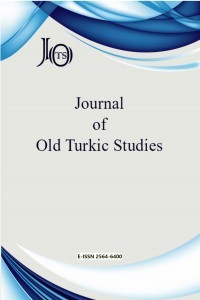Firdevsî’nin Hayât u Memât Adlı Eseri ve İmlâ Özellikleri
Old Anatolian Turkish, Firdevsî, Hayât u Memât, Religion, Sufism, Manuscripts
Firdävsî’s Work named Hayât u Mamât and its Orthographic Features
Old Anatolian Turkish, Firdevsî, Hayât u Memât, Religion, Sufism, Manuscripts,
___
- ARAT, R. R. (1953). “Türkçe Metinlere e/i Meselesine Dâir”, Rocznik Orientalistyczny, 17: 306-313.
- BİLGİN, A. (2007). “Türk Tasavvuf Edebiyatı Literatürü”, Türkiye Araştırmaları Literatür Dergisi, 10/5: 334-335.
- BÜKE, H. (2015). “Firdevsî-İ Rumî, Hayatı ve Eserleri Hakkında Yeni Bilgiler”, Mehmet Akif Ersoy Üniversitesi Sosyal Bilimler Enstitüsü Dergisi, 13: 481-501.
- BÜYÜKKARCI-YILMAZ, F. (2013). “Firdevsî, Şerefeddîn Mûsâ, Uzun Firdevsî, Firdevsî-i Rûmî, Firdevsî-i Tavîl, Türk Firdevsî, (Türk Edebiyatı İsimler Sözlüğü, online)
- CEYLAN-YILMAZ, E. (1991). “Ana Türkçede Kapalı e Ünlüsü”, Türk Dilleri Araştırmaları, 1: 151-165.
- ÇALIŞKAN-ATASOY, F. (2019). Firdevsî-i Tavîl’in kitâb-ı Hayât ü Memât Adlı Eseri: Tahlil ve Metin, Fatih Sultan Mehmet Vakıf Üniversitesi, Lisansüstü Eğitim Enstitüsü, Tarih Anabilim Dalı, İstanbul. (Yayımlanmamış Yüksek Lisans Tezi)
- ÇETİNKAYA, A. (2020). Kitâb-ı Hayât u Memât (Giriş-İnceleme-Metin-Dizinler), Sakarya Üniversitesi, Sosyal Bilimler Enstitüsü, Türk Dili ve Edebiyatı Anabilim Dalı, Sakarya. (Yayımlanmamış Yüksek Lisans Tezi)
- DEVELLİOĞLU, F. (2007). Osmanlıca-Türkçe Ansiklopedik Lugat, Ankara: Aydın Kitabevi.
- EMRE, A. C. (1946). “Türkçede Bulanık e (é) Fonemi”, Türk Dili-Belleten, III/6-7: 487-497.
- ERCİLASUN, A. B. (2014). Başlangıçtan Yirminci Yüzyıla Türk Dili Tarihi, Ankara: Akçağ Yayınları.
- ERGÜZEL, M. & M. AYDIN (2010). “Eski Anadolu Türkçesinde Yapım Ekleriyle Türk-çeleşen Arapça, Farsça Kelimelerin İmlâsı ve İbn-İ Âdil Melhamesi’nden Yansımalar”, Uluslararası Eski Anadolu Türkçesi Araştırmaları Çalıştayı Bildirileri, Eds. E. DOĞAN & M. ÖZKAN, İstanbul Üniversitesi Yayınları, İstanbul: 157-169.
- FOY, K. (1903). “Azerbajganische Studien mit einer Charakteristik des Südtürkischen I”, Mitteilungen des Seminars für Orientalische Sprachen, 6: 126-193.
- FOY, K. (1904). “Azerbajganische Studien mit einer Charakteristik des Südtürkischen II”, Mitteilungen des Seminars für Orientalische Sprachen, 7: 197-265.
- KORKMAZ, Z. (2005). “Eski Anadolu Türkçesinin Türk Dilindeki Yeri”, Prof. Dr. Fikret Türkmen Armağanı, Kanyılmaz Matbaası, İzmir: 471-473.
- KÖPRÜLÜ, O. F. (1996). “Firdevsî, Uzun”, Türk Diyanet Vakfı İslâm Ansiklopedisi 13, Türk Diyanet Vakfı Yayınları, İstanbul: 127-129.
- NÉMETH. (1939). “Zur Kenntnis des Geschlossenen e im Türkischen”, Körösi Csoma-Archivum, 1: 515-531.
- Sami, Şemseddin. (2005). Kâmûs-ı Türkî, İstanbul: Çağrı Yayınları.
- ŞAHİN, H. (2003). Eski Anadolu Türkçesi, Ankara: Akçağ Yayınları: 13-29.
- TİMURTAŞ, F. K. (1994). Eski Türkiye Türkçesi, İstanbul: Enderun Yayınevi.
- TİMURTAŞ, F. K. (2011). Osmanlı Türkçesi Grameri (Eski Yazı ve İmlâ, Arapça, Farsça, Eski Anadolu Türkçesi), İstanbul: İstanbul Üniversitesi Edebiyat Fakültesi Yayınları.
- TURAN, Z. (1999). “Eski Anadolu Türkçesinde Ol- Cevheri Fiili”, Türk Dili Araştırmaları Yıllığı-Belleten, 44: 265-289.
- TURAN, Z. (2012). “Orta Türkçe Metinlerinde Kelime Başı Ünsüzlerinde Aşırı Patlayıcılaşma Var Mıydı?”, İstanbul Üniversitesi Edebiyat Fakültesi Türk Dili ve Edebiyatı Dergisi, 30: 539-558.
- Yayın Aralığı: Yılda 2 Sayı
- Başlangıç: 2017
- Yayıncı: Erdem UÇAR
Additional Turkic and Tungusic Borrowings into Yukaghir V
Dede Qorqut Kitabı’ndaki Bazı Tartışmalı Yer Adları Üzerine
Eski Uygurca Asgançu ve Asgançula-’nın Kökeni Üzerine
Firdevsî’nin Hayât u Memât Adlı Eseri ve İmlâ Özellikleri
Runik Harfli Eski Türk Yazıtlarındaki Ses Olayları
The Uybat Inscriptions: a Group of Old Turkic Runic Texts from the Yenisei Area
Eski Anadolu Türkçesi Dönemine Ait Bir Eser: Aksaraylı Îsâ, Destân-ı İsmâîl [06 Mil Yz A 6823/5]
